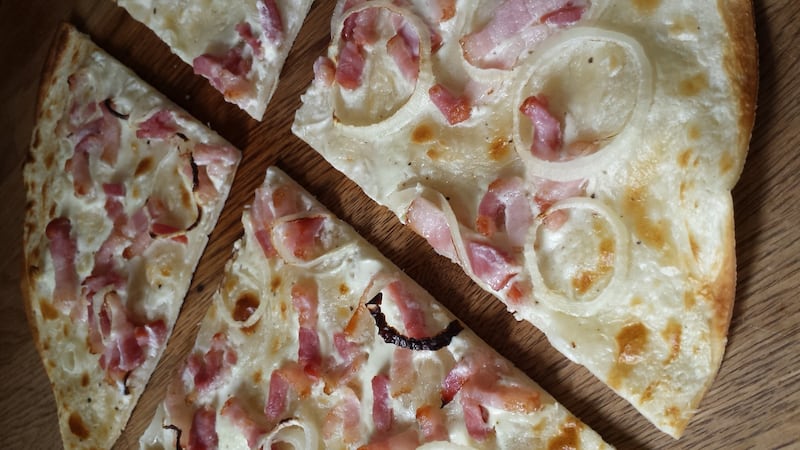Outside of the German-speaking world, German food isn’t rated very highly. When was the last time you saw a German restaurant, or even a German dish on a menu? Even now you are probably thinking of bratwurst, sauerkraut and liver sausage, and mentally turning up your nose at it. Beer and black forest gateau are about the only successful culinary exports.
I am puzzled at how it came to this, since Germany has a tremendous range of regional cuisine, from the fresh seafood of the north to the hearty dumplings of the south, the east German soljanka soup to the schwabian noodles of the west. Add to that the finest Luebeck marzipan, Nuremberg's lebkuchen biscuits, and Dresden's famous stollen fruit bread, and there really is something for everyone.


Even vegetarians, who may assume German fare is too meat-heavy, are well catered for with seasonal vegetables such as lamb’s lettuce and oak leaf salads, the delicate white asparagus of early summer, and the wild mushrooms of autumn.
I was lucky in my introduction to German food. Starting out here as an au pair to a food-loving Bavarian family, I was fed on the grandmother’s home-cooked bread dumplings, apple strudel and stews. The mother of the family introduced me to schupfnudeln, a finger-shaped potato dumpling fried in butter, and spaetzle, a versatile type of homemade pasta.
Living on the outskirts of Munich, I was able to browse the famous Munich Viktualienmarkt fresh food market on my days off and wander the food halls of Dallmayr, Munich’s equivalent to Harrods’ Food Hall. A few years later I married into another Bavarian family, a family of game hunters and mushroom gatherers, and my culinary education continued.
As I have travelled around the country, many German dishes have made their way into my kitchen. On top of my Bavarian grounding, the nearby Alsace and local wine-making regions of Pfalz and Baden have been a great influence, and there is one local dish that we simply cannot live without: flammkuchen.
Flammkuchen is a speciality here in south-western Germany as well as across the border in Alsace, where it is known as tarte flambee. It is a simple but incredibly flavoursome pizza-like dish. A very thin base somewhere between pizza dough and fresh pasta is topped traditionally with seasoned crème fraîche, bacon and onions, then baked for a few minutes in a very hot oven.
The tart is then sliced into pieces, placed in the centre of the table and eaten with the hands. Tart after tart is ordered until everyone at the table is full. The topping can be varied to include garlic, cheese or mushrooms. There is also a sweet version with apples and Calvados.
Flammkuchen
This recipe makes five tarts, which will serve five as a meal, or up to ten as a snack with beer or wine.
Ingredients
Base:
300g plain flour
100ml water
4 tsps oil
½ tsp salt
Topping:
400g crème fraîche
2 medium onions, peeled and finely sliced into rings
400g bacon lardons
Salt
Black pepper
Method
1. Pre-heat the oven to 220°C.
2. In restaurants, Flammkuchen are baked in wood-fired ovens, giving them an extra crispy base. At home you can ensure a crisp base by pre-heating your baking tray in the oven before baking the Flammkuchen, and using only a small amount of topping per tart so that it cooks quickly.
3. In this region of Germany and in Alsace you can buy the Flammkuchen bases in supermarkets. As an alternative you could use thinly rolled out puff pastry, or flour tortillas. To make your own base from scratch, combine the base ingredients in a bowl and knead to a smooth dough. Add a little more water, is the dough is not coming together well. Wrap in clingfilm and refrigerate while you prepare the remaining ingredients.
4. Place the crème fraîche into a bowl, season lightly with salt and black pepper and stir well. Remember the bacon will contribute to the overall saltiness of the dish.
5. Divide the dough into five equal-sized portions. Roll out one of the dough portions to a circle, rolling the dough as thinly as possible. Spread the base with approximately 80g of seasoned crème fraîche. Then sprinkle it with bacon lardons and finely sliced onion.
6. Repeat with the remaining four portions of dough and the remaining crème fraîche, bacon and onions.
7. Slide the tart onto the pre-heated baking tray and bake for 8-10 minutes. It should be crisp and lightly browned. Place the next tart in the oven and serve the first while the second bakes. Repeat until all the tarts have been baked.
Fionnuala Zinnecker has written previously for Generation Emigration about life in Germany, and blogs family life at threesonslater.blogspot.com and cooking at mykitchennotebook.blogspot.de.












